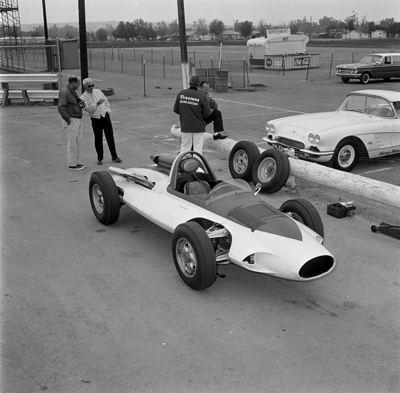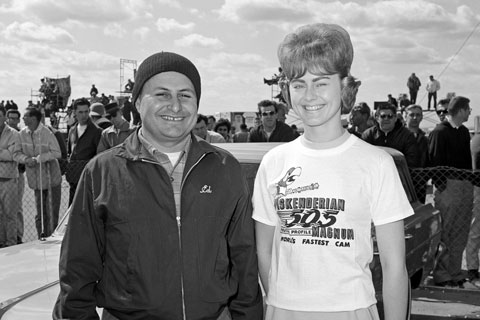SEMA News—October 2019
HERITAGE
By Drew Hardin
Grandfather of the C8 Corvette
Photo Courtesy Eric Rickman, Petersen Publishing Company Archive
 |
Those who tuned in to the live-stream introduction of Chevrolet’s mid-engine C8 Corvette in July saw vintage footage of a single-seat roadster driving around GM’s Milford Proving Grounds and fishtailing up the dirt switchbacks of Pikes Peak. Chevy’s ’20 Corvette has roots back to that little car, the first Chevrolet Engineering Research Vehicle, or CERV I.
Many are familiar with Zora Arkus-Duntov, the passionate Belgian engineer who was almost single-handedly responsible for persuading Chevrolet to up the Corvette’s performance game in the mid-’50s. When it debuted in 1953, the Corvette was more boulevard cruiser than sports car, its swoopy fiberglass body powered by a pedestrian six-cylinder engine. Thanks to Duntov’s efforts, a small-block V8 went into the Corvette for 1955, and the car’s fortunes turned. On Duntov’s watch, the Corvette set records on the sand at Daytona Beach, won races against fierce European and domestic competition, and proved popular at the showroom as well.
Duntov’s goal of creating a world-class sports car was coming true. But he realized even then that a whole new level of performance could be achieved with a radical reimagining of the car’s layout. Packaging the engine behind the driver (a trend that was beginning to take hold in Formula 1 and would soon make its way to Indianapolis) would center the car’s mass, a tremendous advantage for handling and the driver’s visibility. In 1959, he began work on what would become CERV I to test that and other high-performance concepts.
Duntov shook the car down at Milford and on the Peak and then debuted it publicly at Riverside Raceway in November 1960. Hot Rod was on hand to document the event, while racers Dan Gurney and Stirling Moss shared driving duties with Duntov.
Hot Rod Technical Editor Ray Brock (seen in the photo at the rear of the car talking to Duntov in the sunglasses) described the CERV I as “Designed to test new engineering ideas… [with] fully independent suspension, transaxle, tube frame and 350-lb. aluminum V8 with one horsepower per pound.” Brock noted that “the car was run in excess of 170 mph” at Milford, while the run up Pikes Peak “produced times comparable to those turned in by the fastest championship cars.” At Riverside, both Gurney and Moss ran laps of around 2 minutes 4 seconds, not far off Moss’s lap record of 1 minute 55 seconds, which he set in a Lotus Grand Prix car.
Ultimately CERV I would be tested for several years using a variety of engines and would lead to two more test mules carrying the CERV designation, in 1963 and 1990, as well as a number of mid-engine prototype and concept cars. Rumors of those concepts becoming a mid-engine production Corvette would ebb and flow over the years, but it took six decades before Duntov’s mid-engine dream would finally become reality.






